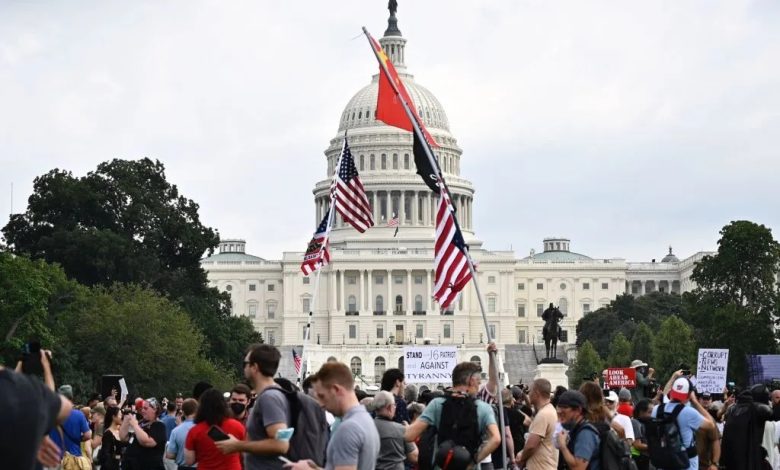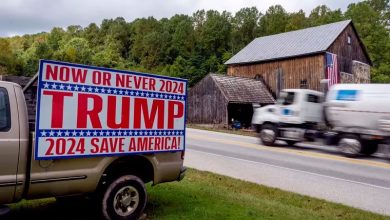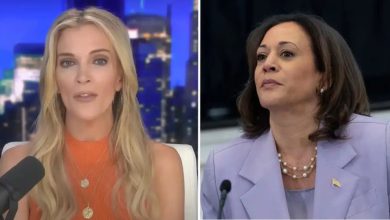Bombshell J6 Transcripts Vindicate Trump, Blow Massive Hole In Democrat Narrative

A batch of interviews that took place following the January 6th, 2021 breach at the Capitol have shed new light on President Donald Trump’s efforts to dispatch authorities tasked with quelling unrest and protecting lawmakers as they certified the 2020 election results.
Bombshell testimony released by Congressman Barry Loudermilk (R-GA) on Thursday indicates that President Trump initially requested additional ground support from the National Guard or active duty troops but was rebuffed. The disclosure came while investigators interviewed Gen. Mark Milley, the former chairman of the Joint Chiefs of Staff, who confirmed to the Pentagon inspector general in 2021 that President Trump in an Oval Office meeting pre-approved the deployment. Rep. Loudermilk shared the results of the House GOP’s ongoing investigation with Just The News.
“The President just says, ‘Hey look at this. It’s going to be a large amount of protesters come in here on the 6th, and make sure that you have sufficient National Guard or Soldiers to make sure it’s a safe event,’” Milley told the inspector general during the Pentagon’s J6 investigation. He added that then-acting Defense Secretary Christopher Miller assured Trump that the Pentagon had protocol in place to keep the peace in Washington, D.C. that day. “Miller responds by saying, ‘Hey, we’ve got a plan, and we’ve got it covered.’ And that’s about it,” Milley recalled.
“‘Just be sure it’s safe,’” Milley claims Trump told his team. “It was just what I just described, which was, ‘Hey, I don’t care if you use Guard, or soldiers, active-duty soldiers, do whatever you have to do.’” Milley sat for two interviews that year, one on April 8th and a second on April 16th, the transcripts of which Rep. Loudermilk obtained as part of a GOP-led probe into what House Speaker Mike Johnson and allies maintain was a politically-motivated congressional committee seeking to lay the blame on Trump.
According to Milley, an interagency plan involved positioning National Guardsmen on the streets to direct traffic but not to guard the Capitol building, a plan that was signed off on by Democratic D.C. Mayor Muriel Bowser. “The operational plan was this, let’s take the D.C. National Guard, keep them away from the Capitol. Let’s put — the request, it wasn’t my request, Bowser and her Metropolitan Police Department were like ‘Let’s put D.C. National Guard on traffic control points and at the Metro stations to free up credentialed law-enforcement officers that can go out and arrest people,’” Miller explained, admitting there was a “political calculation” to keep troops away from Congress.
“I hate to use the word optics because it’s been used and so prejudicially and negatively. It wasn’t the optics. It was like there was… would have been huge political consequences for that, because that’s what I got paid to do. I had to factor in the politics of this and that was my concern, is the situation does not warrant at this time U.S. military forces,” he explained.
In a concurring interview, former District of Columbia Metropolitan Police Chief Robert Contee recalled that it was Army Secretary Ryan McCarthy who resisted his call to station troops around the Capitol. “I received a call directly from the Secretary of the Army Ryan McCarthy and at that time — at that point he had reviewed our request for the support of D.C. National Guard, and what he relayed to me on this phone call was not what I initially thought that he would say,” Contee recounted in his interview. “He did not initially say, ‘Yes, you get the National Guard responding and they’re going to handle this traffic and crowd management that you asked for, that they’re going to be responding to handle it.’”
“That was not what was stated. What was stated to me was that he was not inclined to fulfill the request with Guardsmen simply because the optics of it was bad,” Conte added. “He said that he did not want to have boots on the ground on the — he didn’t want to have boots on the ground anywhere near the Capitol is what was stated.”
In a social media post, Rep. Loudermilk expressed his concern that there were political considerations at play when high-ranking military figures like McCarthy and others opted to deny requests to put a police force around the Capitol building. “President Trump directed senior DoD leaders to ensure events on J6 be safe. They ignored his guidance, prioritized optics concerns over security, and pushed a flawed narrative in their IG report,” he wrote on X last week. “The American people deserve the full truth.”
President Trump directed senior DoD leaders to ensure events on J6 be safe.
They ignored his guidance, prioritized optics concerns over security, and pushed a flawed narrative in their IG report.
The American people deserve the full truth.https://t.co/2sAxqsvoZe
— Rep. Barry Loudermilk (@RepLoudermilk) September 20, 2024
Eventually, McCarthy approved the stationing of 400 Guardsmen throughout D.C. to direct traffic but explicitly stated they were not authorized to use force against protestors. “[D.C. National Guard] are not authorized to perform any additional tasks or duties not authorized in this memorandum,” McCarthy’s staff wrote to the National Guard commander on Jan. 5, 2021. “In addition, without my personal authorization, the DCNG is not authorized the following: a,) to be issued weapons, ammunition, bayonets, and batons. (Removed body armor and helmets),” he wrote in a December 2020 email. “Addition: DCNG Soldiers have the inherent right to self‐defense. DCNG Soldiers will store their helmets and body armor within vehicles or buildings in close proximity to their positions. In the event of an elevation of the threat requiring immediate donning of this equipment for self‐defense, DCNG leadership will immediately notify the Secretary of Army,” that email read.
As violence escalated that day, it took the Pentagon several hours to deploy hundreds of additional troops. Before they could reach the Capitol, rioter Ashlee Babbitt, a Trump supporter, was shot and killed by a Capitol police officer. DC Homeland Security Coordinator Christopher Rodriguez also told Pentagon investigators in 2021 that an Army official used the word “optics” to defend why McCarthy denied a use-of-force authorization. “I do believe it was one of the generals that was on the line from Secretary of Army staff that I referred to,” Rodriquez recalled.
Pressed by the outlet what he heard on that call, Rodriquez added, “It shocked me quite frankly. And we recognize that we might not be able to get an answer to getting needed support up to the Capitol in a timely fashion.”
The Pentagon’s inspector general ultimately concluded that leaders acted quickly to suppress the outbreaks of violence, noting McCarthy approved the use of additional troops within 45 minutes of the first attack. That doesn’t square with what Rep. Loudermilk said he sees in the transcripts. “The DC National Guard was significantly delayed from deploying to the U.S. Capitol on J6 because senior DoD leaders had ‘optics’ concerns,” Loudermilk wrote on X earlier this month.
Former Defense Secretary Miller said he recalled President Trump explicitly calling for “10,000 troops” on the streets of Washington that day, a figure he chalked up to political bluster. “The President commented that they were going to need 10,000 troops the following day…I interpreted it as a bit of presidential banter or President Trump banter that you all are familiar with, and in no way, shape, or form did I interpret that as an order or direction,” Miller testified. General Milley denied that the figure was thrown out by Trump.
Whatever the case, the interviews laid bare the disdain of Trump held by military leaders. At one point, Miller compared Trump to the former Cuban communist leader Fidel Castro. “Everyone was like, ‘Did you listen to the President’s speech?’ I’m like, ‘The guy speaks for 90 minutes, it’s like Castro or something. No. I’ve got work to do,” he told the inspector general.



